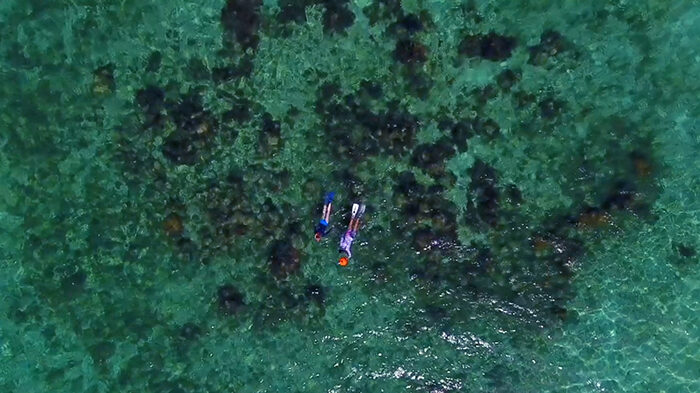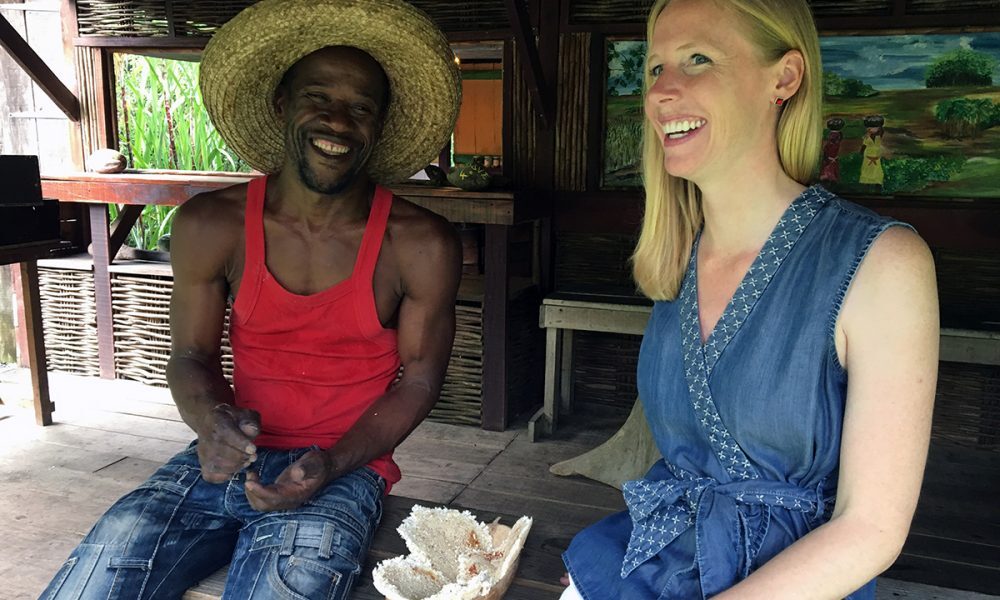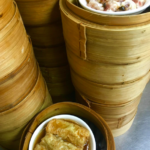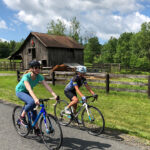Martinique’s top hotels, resorts, restaurants and attractions, based on what we filmed for our PBS travel TV show.
This Martinique Vacation Itinerary is packed with top restaurants, markets, hotels, and attractions you’ll want to consider for your trip. If you haven’t considered Martinique for a Caribbean vacation, you should. It’s a destination that combines beautiful beaches with lots of interesting cultural attractions and good food.
An overseas department of France, the island is located in the Lesser Antilles, nestled between Dominica and St. Lucia. Martinique combines pretty beaches and bays with lush rainforests and mountains, quiet fishing villages and vibrant culture.

This travel itinerary outlines some of the top places to take a deeper dive into Martinique. Learn about where we took a sailing lesson and enjoyed top snorkeling. Eat at beachside bars and with Michelin-star chefs. Find out what you must drink while in Martinique and where to find the best rum distilleries and enjoy eco-friendly nature at botanical gardens and history at interesting museums.
This trip to the Caribbean can involve more than just a day at the beach!
Day 1: Arrive to Martinique and Stay in Fort-de France Vie. Touch down at Martinique’s Aimé Césaire International Airport, collect your luggage and rent a car for this itinerary.
Martinique Accommodations Travel Tip: If you aren’t headed directly to a resort, stay tonight at Le Simon Hotel, a modern hotel right in Fort-de-France. Though we do recommend either renting a car or hiring a car and guide for this trip, Le Simon Hotel is centrally located in Fort-de-France, steps away from La Savane Park and downtown shopping and restaurants, so you can walk from these accommodations. The hotel has 94 rooms, two suites, one apartment and Wi-Fi. There’s also a restaurant on-site.
Fort-de-France Restaurant Tip: We enjoyed dining at La Table de Marcel inside Le Simon Hotel, where Michelin-star chef Marcel Ravin cooks up innovative dishes combining local spices, herbs, and Creole seasonings with traditional French flavors, like Manioc truffles and beet risotto. For more casual eats, dine right across the hall at Le Bistro des Flamands.
Day 2: Fort-de-France If you can rise early, do so to catch the stunning sunrise over Fort-de-France’s harbor. Next, put on comfortable walking shoes or sandals and explore the city!

Explore Fort-de-France on foot. It’s a walkable city. Make sure to take a walk through La Savane, Martinique’s palm tree laden version of Central Park. Check out the statue of a headless Empress Josephine, the first wife of Napoleon.
The statue wasn’t originally installed that way. Locals beheaded the statue in the 1990’s and later splattered it with red paint. To put it lightly, there are mixed feelings about Josephine. Some Martinique residents believe that Josephine helped to convince Napoleon to reinstate slavery in all the French colonies when France regained control of its colonies from the British and may have done so to help bolster her family’s plantation in Martinique, where 200 slaves worked in the mid-18th century.
The estate, which now houses a museum to Josephine rests across the bay in Trois-Ilets. Interestingly, the statue’s head has never been recovered and so you can only partially pay tribute to one of Martinique’s most famous residents in La Savane.
Schoelcher Library: Across from La Savane, marvel at the architecture of the Schoelcher Library. The library was built during the 19th century in Paris for the World Exposition and rebuilt in Fort-de-France. It’s named for abolitionist writer Victor Shoelcher, an outspoken opponent of slavery. Shoelcher was instrumental in helping to abolish slavery in the Caribbean, including in Martinique in 1848. The library holds Shoelcher’s vast collection of books and music scores with the aim that these resources be available and freely accessible to former slaves.
Grand Marche or Covered Market: Walk towards the Grand Marche or Covered Market. On the way, stroll down Rue Victor Hugo, one of the main shopping streets, and get a feel for the city. The covered market houses everything from fresh fruits and vegetables to spices and flowers to homemade liquors. If you visit during the holidays, you may get to hear live Christmas Carols and at other times, live steel drums, and sometimes both.
Aime Cesaire Museum: Walk from the market over to the Aime Cesaire Museum. Housed in the old Hotel De Ville, the city hall of Fort de France, and now a theatre and museum, this small, one room museum, is housed in the former office of Aimé Césaire. One of Martinique’s most famous resident’s, Aimé Césaire was a poet, author and politician, called the most influential Francophile Caribbean writer of his generation. He helped found Negritude, a movement that sought to restore the cultural identity of black Africans. He also served as mayor of Martinique and remains a beloved icon of Martinican residents.
On April 17, 2008, Aimé Césaire passed away in Fort-de-France and his office inside the theatre pays tribute to his legacy.
Le Malecon to Fort Saint Louis: Take a stroll along La Malecon, Martinique’s boardwalk, over to Fort Saint Louis. Get tickets in a kiosk in the park en route to tour the fort. Built by the French in 1638, Fort Saint Louis has seen many battles. The fort has been a strategic stronghold for the French in maintaining a base in the Caribbean throughout the centuries.
This may take you all day! If not, have lunch in the city, before heading to Balata Gardens, just a twenty minute drive from Fort de France. If you spend all day in the city, consider bumping the Balata Gardens to another day.
Balata Gardens: From swinging bridges to a myriad of swaying palm trees and tropical flowers, Balata Gardens, Jardin de Balata, is a stunning place to take a stroll. Created in 1982 by horticulturalist Jean-Philippe Thoze, whose family owned the property, the Balata Garden opened to the public in 1986. Originally Thoze used the property as a sort of storage place for the multitude of plants he collected on his global travels. The Balata Gardens are home to thousands of diverse tropical plants and hundreds of species of palm trees. You’ll definitely see something eye catching that you’ve never seen before at these botanical gardens.
Walking amid the treetops, is a fun way to enjoy a birdseye view of the lush rainforest setting and more unique flowers. Back at the Creole style main house with its period furnishings, make sure to take the time to watch the hummingbirds in this truly spectacular setting. Stay tonight again at Le Simon Hotel.
Day 3- Black Sand Beaches & Chef Hot Pants Rise super early to catch another stunning sunrise and head to the fishing village of Le Carbet. If you’re lucky, you’ll see the locals participating in a traditional type of fishing is done in the village of Le Carbet called Coup de Sene. It happens at sunrise and you can participate or just watch from the beach.

Look for this guy, Chef Hot Pants, at Le Petibonum. You’ll spot shorts! Spend the rest of the day lounging at Le Petibonum, a restaurant located on a black sand beach in Le Carbet. Frolic in the water and have a Planteur, a rum punch and the island’s signature drink, or Ti Punch, which can be strong. Ask for Chef Guy Ferdinand, aka Chef Hot Pants, at Le Petibonum and make sure to try the catch of the day. When we visited, local fisherman brought in a large Marlin and Chef Hot Pants sliced it up on the spot to create a super fresh tartare.
Have some tartare at sunset at Le Petibonum and a cocktail, too. Stay here for dinner in the open-air restaurant, where live bands and DJ’s delight locals and travelers, or head back to Le Simon in Fort-de-France.
Day 4- Saint Pierre Visit the “Little Pompeii of the Caribbean,” Saint Pierre.
Coined the “Little Paris of the West Indies” in the 19th century, Saint Pierre is the former capital of Martinique.
A bustling port city with a population of around 30,000 when the volcano erupted, Saint Pierre was wiped out by hot gas and volcanic debris in a matter of minutes. There were only a few survivors, one of whom was a man who had who had been imprisoned for drunkenness. Stories have circulated that his survival earned him some acclaim and he later went on tour with the Barnam & Baily Circus. You can visit his cell today and walk amid the ruins and rebuilt city, including the ruins of the old theatre.
This is the postcard view of Saint Pierre. You can get it along the drive from Fort-de-France to Saint Pierre. Look for a small pull off just before you reach Saint Pierre. Grab a bite in Saint Pierre before heading up to the Emerald Estate, Domaine d’Emeraude, a stunning garden and educational center located in Morne-Rouge. Here tropical flora and fauna, many of which has traditional cultural significance, blankets the hillsides, including in the Creole garden, where medicinal plants and herbs are grown, encourage the next generation to keep their Creole roots alive. Take a walk through the forest and learn about native plants and more.
On the way back from the gardens, make a stop at Depaz Distillery and walk the grounds of this distillery with its stunning views of the volcano. Driving onwards, make another stop at the best ice cream shop in Martinique.
At Ziouka Glaces (15 Place Jules Grevy, Face à l’Eglise, Le Carbet), Mr. Ziouka uses locally sourced fruits, vegetables and spices to infuse French Creole flavors into artisan ice creams and sorbets. Island flavors like banana rum, manioc, guava, sugarcane, passion fruit and beyond are truly fresh and delicious, but you may have to wait in line to get a scoop.
Day 5- Snorkel and Sail, Hike an Eco-Plantation or Rum Taste
Today, we recommend either snorkeling and sailing or visiting an eco-plantation. If you want to snorkel and sail, drive about an hour and fifteen minutes to Le Robert. At the marina, slather on your sunscreen and get ready for your sailing lesson with Denebola.
I’d never sailed a boat myself before and found it easy with owner Delice Nouel’s help. Ride out to Ilet Madame and drop anchor to enjoy snorkeling over the beautiful reefs amid clear water. Your swimming around les Fonds Blans by Ilet Madame. Delice may also take you to Ilet Chancel to see the iguanas, though we didn’t have time to do that.
Enjoy lunch and possibly a homemade Planteur onboard before returning to shore. Alternatively, get deeper into the island’s interior by driving to Habitation Ceron to see Le Zemana, a 300-year-old-tree, and hike the wild grounds of this former sugar factory and its ruins. Have lunch on-site. The restaurant is known for its crayfish. If you don’t feel like any of the above or snorkel for part of the day and want to fill the rest, you’re close from Le Robert to Habitation Clement.
At this 18th century rum distillery and historic sugarcane plantation rhum agricole production dates back over 125 years. Martinique is known for its varieties of rum agricole, which is rum produced with fresh sugarcane juice as opposed to molasses.
In addition to the cellars and a museum, Habitation Clement’s grounds are like an open air art gallery, with sculptures on display amid stunning trees and contemporary art housed in modern galleries, but a centerpiece of this estate is the main home, the only Creole building recognized as a French historical monument in Martinique.
World leaders including President George H.W. Bush have visited and held meetings in this stunning open-air home, perched on top of a hill overlooking the estate. Walk the grounds to see a variety of interesting art and beautiful trees. Also, make sure to see what is on exhibition at the Foundation, before hitting the store to rum taste and bring home a few bottles. This rum is not easily found in the USA!
With rum in hand, depart the distillery and head to Vauclin to Le Domaine des Bulles, aka The Field of Bubbles. Started by three brothers who grew up on this forested property on the Eastern side of the island and wanted to start a business that helped preserve their land and helped travelers to experience it in all its majesty, this is definitely one of the most unusual places to stay I’ve ever visited, but hearing the night sounds of nature in this private setting is truly special.
We think this is a bragging rights place to stay. When else can you stay the night in a bubble? You will hear the sounds of nature. If you’re not into “glamping,” travel on to either Bakoua Hotel with its beach and resort feel or stay at boutique La Suite Villa, where owner and art collector Gilles Duplan takes Martinique’s love of color to another level. Both are located in Trois-Ilets. Whether you stay there or not, consider stopping for a drink at Hotel Bakoua’s Coco Bar, an iconic tiki style beach bar that juts out over the water.
Day 6- Slave Savannah & The Beach
Visit La Savane des esclaves or Slave Savannah to learn more about the history of slavery in Martinique. Created by local Gilbert Larose, who is passionate about keeping island ancestry and traditions alive, Slave Savannah contains historical and recreated artifacts, medicinal and organic vegetable gardens, livestock, and a series of slave huts, placing the traveler back in a 19th century slave village.
Learning to make cassava, a staple on the island, with Slave Savannah’s Gilbert Larose. Each small hut may have housed an entire family, who would depend on their own subsistence growth and herbal medicines to survive. Through paintings, sculptures, historical drawings and photographs, visitors are transported through the hard and horrific lives slaves faced from their capture from their homeland and transfer to Martinique through their daily work on plantations and eventual freedom.

Head to the beach for lunch to Ti Sable Restaurant, where you can lay down in a long chair with a cocktail, take a dip in the ocean, snorkel or just eat by the sea. Visit the dock by the town’s historic church at Les Anses-d’Arlet, one of the island’s most photographed locations.
If you pick up a Martinique postcard, this is the image you’ll most likely see. Whether you stay there or not, enjoy dinner at La Suite Villa. A stunning pool overlooking the Fort de France Bay and top restaurant, Le Zandoli, are a good reason to stop by, even if just for a cocktail.
Day 7- The Pottery Village, Slave Memorial & a Top Beach
Visit of Le Village de la Poterie, the Pottery Village, in Trois Ilets and have lunch and shop for handmade, local pottery. Located on a former Jesuit monastery and later a sugar plantation, the Pottery Village dates back to the 18th century and is today a place where travelers can meet modern artists and gain an unique appreciation for the red clay soil that’s transformed this part of the island.
Drive about a half hour to Le Diamant to visit the Slave Memorial, located in a dramatic setting on Martinique’s Southern coast across from Diamond Rock. Artist Laurent Valère created a memorial here to recognize the slaves who perished during an April 1830 shipwreck that took the lives of more than 40 African slaves.
The Anse Cafard Slave Memorial across from Diamond Rock is a must-see. Enjoy one of the best beaches in Martinique, Les Salines. Sugary white sand, palm trees and warm, clear water make this beach a stand out, as do local vendors who sell everything from French fries to coconut sorbet. Enjoy a scoop and this stunning beach.
If you have time, consider adding on an eco-tour to see the mangrove trees with Taxi-Cap, which specializes in taking travelers to view Martinique’s unique mangrove ecosystem and eleven protected islets, very small islands off the coast of Saint Anne.
Feel free to use this itinerary as simply an idea guide. We covered a lot on our trip. You don’t need to do so much! You’re in the Caribbean, so make sure to make time to relax. After all, you can always go back for another trip.
Note: Many of the above sites we link to are in French. For more information, search for videos and other articles on our website.



